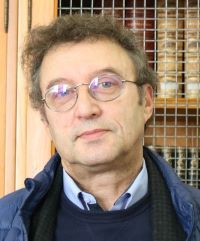
Smail Triki
Université de Brest, France
Talk: Synergy between spin crossover, fluorescence and viscoelasticity in soft nanocomposites
Biography:Smail TRIKI is a Professor in Chemistry at the University of Brest and head of the “Switchable and Polyfunctional Materials” Group (CEMCA, UMR CNRS 6521) at the same university. His research work is located the field of molecular chemistry, including design and syntheses, and covers certain aspects of material sciences, such as magnetic, switchable, luminescent materials, including multifunctional systems. He has led or contributed to several ANR, European, and international research projects, and published more than 150 papers.
Abstract:Among the switchable materials, the spin crossover (SCO) complexes are of particular interest, notably because of their potential applications in the development of new generations of electronic devices.[1] However, these molecular systems, generally characterized as crystalline powders, can be sensitive to normal atmospheric conditions and are difficult to process. Such limitations and their conjunction with the desire to develop multifunctional systems displaying other physical properties such as fluorescence,[1b,1c] have prompted some groups, since the last two decades, to develop composite systems resulting from the dispersion of cooperative SCO complexes in polymer matrices chosen for their physical and mechanical properties.[1d] Following this approach, we focused on organic polymers exhibiting viscoelastic behaviour and other properties such as fluorescence or electric conductivity, with the aim to design soft multifunctional composites. In this context, we have prepared several series of soft nanocomposites based on the “FeII-triazole” cooperative SCO chains, dispersed in the viscoelastic and fluorescent sodium polystyrene sulfonate (NaPSS) matrix.[2] In this contribution we describe a series of critical-like gel nanocomposites showing strong coupling between spin crossover, fluorescence and viscoelasticity.

Mohamed-Ramzi AMMAR
Orléans University, France
Talk Title: Raman Scattering Techniques: From Conventional Analysis to In Situ Experiments
Biography: Mohamed-Ramzi Ammar obtained his Ph.D. from the University of Le Mans in 2007. After spending two years as a postdoctoral fellow at the École Normale Supérieure in Paris, he joined the University of Orléans in 2010 as an Associate Professor and obtained his Habilitation to Supervise Research (HDR) in 2014. His expertise lies in the photophysical properties of materials, including carbon-based materials, transition metal dichalcogenides (TMDs), and organic-inorganic halide perovskites. Ammar’s research currently focuses on the synthesis and characterization of these materials to understand their behavior under various conditions, utilizing techniques such as Raman spectroscopy, steady-state photoluminescence, and time-resolved photoluminescence (~ps-ns).
Abstract: An ideal analytical technique should be fast, non-destructive, and capable of providing high spatial resolution while delivering comprehensive information. Furthermore, it must be applicable across multiple scales, from fundamental laboratory research to industrial applications. Raman spectroscopy, based on the inelastic scattering of light by matter, meets all these criteria, making it a powerful tool for material characterization. This talk will focus first on sp² carbon materials, where angle-resolved Raman spectroscopy has proven particularly effective in investigating symmetry-breaking defects. However, a key challenge lies in obtaining detailed material information in situ, particularly within complex and extreme environments. To address this, examples will be presented on carbon nanotube growth, where Raman spectroscopy is employed under several conditions, including high measurement distances, rapid growth rates, plasma environments, and high temperatures. At very high temperatures exceeding 1000°C, thermal emission becomes dominant, posing additional challenges for spectroscopic analysis. Further examples will highlight oxide-based materials, where time-resolved Raman scattering (~ns) is combined with aerodynamic levitation and CO₂ laser heating to investigate their high-temperature behavior. Finally, the talk will explore the integration of Raman spectroscopy with time-resolved photoluminescence (~ps-ns), demonstrating how this powerful combination provides complementary insights into energy conversion materials, further enhancing our understanding of their fundamental properties and performance.
 Lotfi Bessais
Lotfi Bessais
University of Paris-Est Creteil, France
Talk Title: Multifunctional Co-based intermetallic alloys
Biography: Lotfi Bessais is a professor at the University of Paris-Est Creteil, France. He obtained a doctorate degree and HDR from the University of Paris 7, France. His research interests cover a broad range including nanomagnetic intermetallic materials.
Abstract: Multifunctional R-Co (R= rare earth) intermetallic alloys exhibit performant magnetic, magnetocaloric and important hydrogenation properties. Samples were prepared by high-energy ball milling followed by an optimized heat treatment.
Structural properties were determined using x-ray powder diffraction, while local environment around each cobalt atom were studied utilizing synchrotron beam local probes. Magnetic and magnetocaloric measurements were performed using a Quantum Design magnetometer.
Ab initio FP-LAPW calculations combining density functional theory and the full-potential linearized augmented plane wave method are performed to investigate the electronic and magnetic structure of the Co-based intermetallic alloys. The calculated magnetic moments are in good agreement with the experimental measurements.
The maximum hydrogen absorption content of R-Co reached 1.2 H/M (H/M: hydrogen per metal). High coercivity of 1.7 T are obtained for theses alloys after an optimization of their microstructure. In addition, these uniaxial anisotropic compounds exhibit a large magnetic entropy change at Curie temperature with a magnetocaloric effect equal to 6 J/(kg.K) under low magnetic field of 0-1T. These results indicate that, these nanomaterials are suitable for hydrogen storage, permanent magnet applications and for magnetic refrigeration.

Rui Fausto
University of Coimbra, Portugal
Talk Title: Design, Synthesis and Characterization of Novel Materials Exhibiting Color Polymorphism
Abstract: Color polymorphism is an interesting property of chemical systems which present crystal polymorphs of different colors. In the case of organic molecular crystals, color polymorphism is a rare phenomenon, with only a few examples reported in the literature hitherto. Nevertheless, systems exhibiting color polymorphism have many potential applications in different domains, such as pigment, sensor, and technology industries.
In this lecture, a series of new chemical systems exhibiting color polymorphism will be described. These new systems have expanded the range of colors of the polymorphs of organic molecular crystals, which traditionally were limited to the triad red-orange-yellow, to the green color.
The pathway to these discovers will be presented, starting with the design and synthesis of the compounds, screening of the polymorphs and their physicochemical characterization. A rationalization on the major structural factors responsible for the different colors of the polymorphs will be presented.

Timur Nikitin
Talk Title: From Phase Transitions to Transparent Conductors: Raman Spectroscopy as a Tool for Advanced Device Materials
Abstract: Raman spectroscopy plays a pivotal role in characterizing dynamic materials undergoing phase transitions and in developing advanced functional conductors. In this talk, we present a comprehensive overview of Raman-based findings from recent studies spanning thermosalient molecular crystals, liquid metal composites, and graphene-based transparent conductors. We examine the role of low-frequency Raman modes in monitoring and controlling ultrafast photoinduced phase transitions in 2,7-di([1,1′-biphenyl]-4-yl)-fluorenone crystals, elucidating the connection between vibrational-librational dynamics and structural rearrangements. We also explore how Raman analysis guided the laser processing of eutectic gallium–indium (EGaIn) particles decorated with graphene oxide (GO), enabling the fabrication of highly conductive and semi-transparent electrodes. Furthermore, we discuss the stabilization of GO-coated EGaIn nanodroplets for energy storage applications, where Raman spectroscopy provided critical insights into the partial reduction of GO triggered by interactions with liquid metals, revealing a mechanism crucial for stabilizing GO@EGaIn electrodes. Finally, we highlight the scalable production of large-area reduced GO transparent conductors via nanosecond infrared laser irradiation, with Raman mapping revealing progressive reduction and restoration of the sp² network. Collectively, these studies underscore the essential role of Raman spectroscopy in advancing the characterization, understanding, and development of innovative materials, paving the way for novel technologies in sensors, optoelectronics, actuators, and energy storage.
 Abdelfattah Mahmoud
Abdelfattah Mahmoud
University of Liège, Belgium
Talk Title: A Novel recycling process for Spent Li-ion Batteries
Abstract: The rapid growth of the global lithium-ion battery market poses economic and environmental challenges leading to an increased demand for metal resources. Indeed, the number of spent batteries which are categorized as hazardous and potentially harmful waste has increased dramatically in recent years. Consequently, recycling of spent batteries holds significant importance and emerges as a vital strategy to recover and reintegrate the recovered materials into the battery supply chain. Indeed, recycling of spent Li-ion batteries has attracted a lot of attention because it raises questions about sustainability, resource, and energy security. Recycling mitigates the scarcity of strategic elements used in battery production and reduces associated manufacturing expenses.
Several technologies are used for the recycling of spent Li-ion batteries such as pyrometallurgical, hydrometallurgical, and direct recycling. The concept of direct recycling has has emerged as an innovative and a more sustainable approach because it offers several advantages compared to other traditional recycling processes that require high energy consumption and chemicals utilization. Indeed, direct recycling ensures high recovery rate of cathode active materials while employing simpler processes, compared with traditional recycling processes. In this talk, the current strategies, and emerging technologies in the recycling of spent Li-ion batteries will be discussed. In addition, an efficient, and eco-friendly method for the direct recycling of cathode active materials material will be presented.

